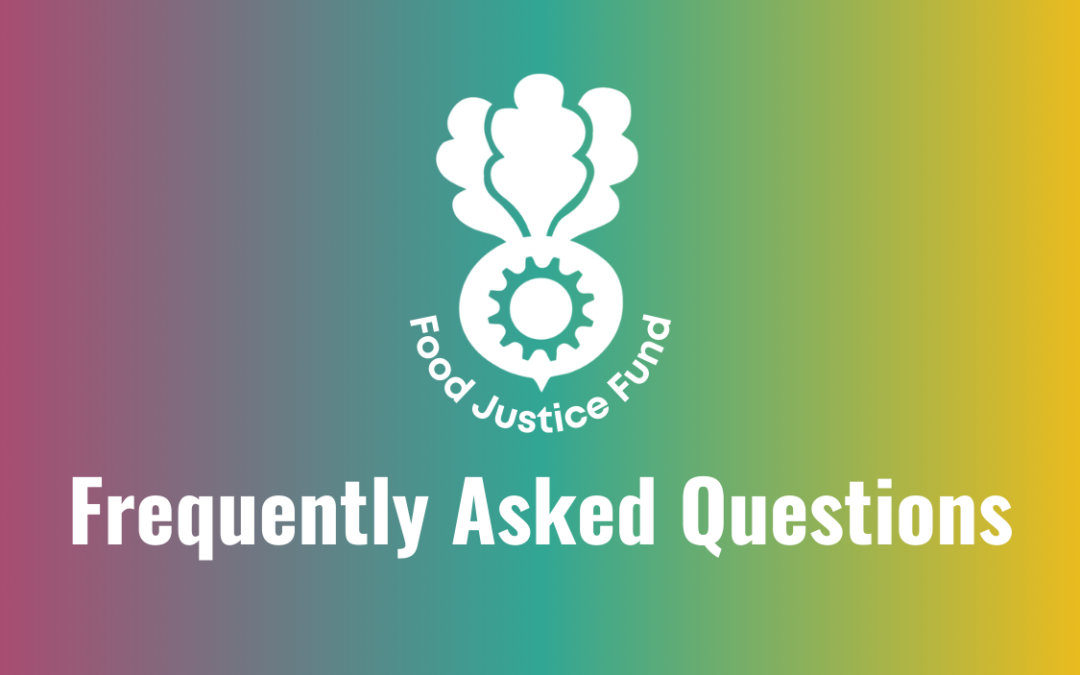Table of Contents
General Information
- What is community grantmaking?
- What are the goals of the Food Justice Fund?
- Where did these funds come from?
- What is the annual timeline for the Food Justice Fund?
- What are the key dates for 2025?
- What is the Food Justice Fund Leadership Council? How are their decisions made?
- How are conflicts of interest dealt with as part of the FJF Leaders’ process?
- How will community voting work?
- How can I contribute to the Food Justice Fund?
Grant Application Instructions
- Where can I find the application?
- What are the funding priorities for 2025?
- What does “grassroots capacity-building” mean as a funding priority?
- What are the two different “Tracks”?
- What information is the funding freeze/Executive Order question aiming to gather?
- What parts of the application are public-facing and which will only be seen by the FJF Leadership Council?
- Where can I view the Info Session recording?
- Where can I get application support?
Frequently Asked Questions
- How many applications may I submit?
- Can I apply for funding if I am not part of a nonprofit organization?
- Can past grantees receive funding in 2025?
- Why should we avoid naming the organization/applicant in the Project Title and Project Overview questions? What are some tips to do this?
- What are you looking for in the Project Overview section?
- What is an indirect cost?
- How will funding “remainders” be dealt with?
- If my project is awarded, how long do I have to spend the funds?
- What are the reporting requirements?
- What if my actual expenditures vary from those I proposed in my budget?
Something else?
GENERAL INFORMATION
What is community grantmaking?
The Food Justice Fund is a community grantmaking project (sometimes called “participatory grantmaking”). That means that the final awardees of this fund will be selected by a vote that is open to anyone over the age of 14 who resides in Syracuse, Onondaga County, or Onondaga Nation. The application process and selection criteria have been designed by the Food Justice Fund Leadership Council (FJFLC) – a diverse group of community leaders committed to building a more just and equitable food system in our region. Read more about the specifics of how voting will work.

What are the goals of the Food Justice Fund?
- Provide flexible funding to projects through an accessible and community-driven selection process.
- Drive public awareness around food justice issues locally.
- Learn about creative food justice solutions that YOU think will make meaningful changes in our community.
- Create a pipeline for great ideas to connect with funding resources beyond the Food Justice Fund.
- Maintain SOFSA’s commitment to redistributing a minimum of 15% of the revenue we bring in to support partners across the network.
Where did these funds come from?
Since 2023 for its annual “Plant A Seed” fundraising campaign, SOFSA’s Advisory Board decided to allocate 75% of funds raised to support efforts across our network to advance food justice – and the idea for this community grantmaking initiative was born! As of February 2025, the Food Justice Fund stands at a grand total of $37,250. The sources of these funds are outlined below:
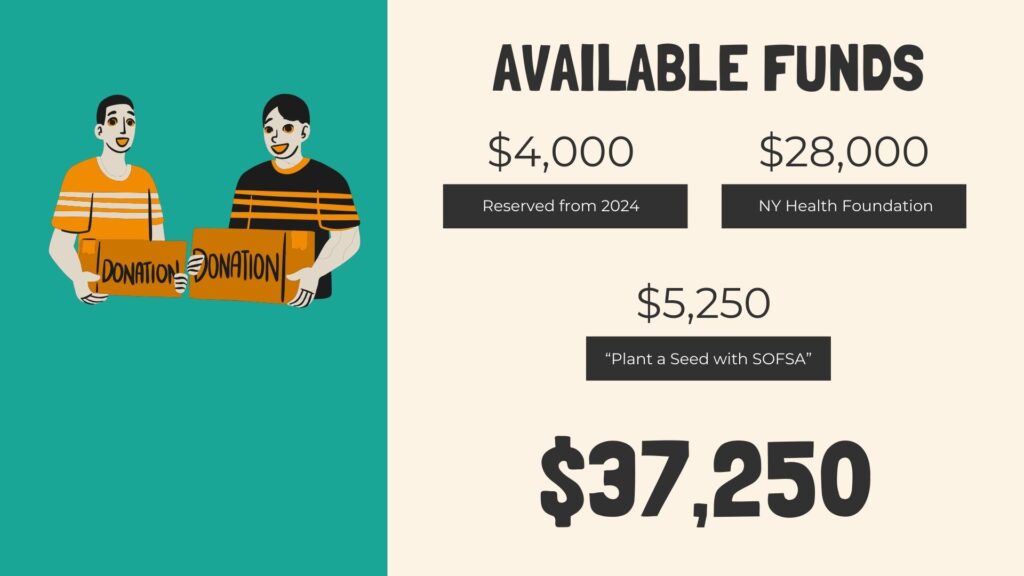
What is the annual timeline for the Food Justice Fund?

What are the key dates for 2025?
| Tuesday, February 18th, 2025 | Food Justice Fund grant applications open |
| Wednesday, February 26th @ 11am | FJF Grant Application Info Session (Hybrid) 🏢In-person at SOFSA’s Office (324 University Avenue, Syracuse, 13210) 💻Virtual on Zoom: https://us02web.zoom.us/j/87851508475 [For those unable to attend, questions may be submitted in advance at https://wkf.ms/40ogia4] |
| Friday, February 28th | Info session recording posted on this page and circulated on SOFSA’s social media channels |
| DEADLINE EXTENDED: Sunday, March 16th | Food Justice Fund applications due |
| March 17th to April 10th | Food Justice Fund Leadership Council reviews all applications |
| Friday, April 11th | Track 1 finalists and Track 2 awardees notified |
| Thursday, April 14th @ 9am | Community voting opens (how will this work?) |
| Thursday, April 24th @ 6:30pm | Community voting ends |
| Thursday, April 24th: from 5:30-7:30pm | 🌟Gather & Grant Celebration🌟 The public is invited to join finalists at Beauchamp Branch Library. Those who haven’t voted previously will have their final opportunity to do so up until 6:30pm, after which awardees will be announced and we will celebrate together! |
| Saturday, October 25th, 2025 | 3rd Annual Food Justice Gathering While some projects may not be fully completed by late October, our hope is that all grantees will have a meaningful story to share about the impact of their project as part of SOFSA’s Annual Food Justice Gathering. |
| October 25th to November 12th | Applications open for 2026 Food Justice Fund Leadership Council |
What is the Food Justice Fund Leadership Council? How are their decisions made?
The Food Justice Fund Leadership Council (FJFLC) is a diverse group of community leaders committed to building a more just and equitable food system in our region. They were selected through an application process during the fall. The group is comprised of the following talented individuals who’ve lent their time and talent to designing this grantmaking process together:
- Jed Locquiao
- Kanischa Miller
- Amy Tao Woodley
- Laura Vasquez
- Katie Purcell
- Debra McClendon-Boddie
Non-voting advisors help to facilitate conversations among the FJF Leadership Council and offer context to support their decision-making. This year’s FJFLC Advisors are:
- Terrlicia Shipe, 2024 FJF Leadership Council Alum
- Maura Ackerman, SOFSA staff member
- Micah Orieta, SOFSA staff member
Over the course of its work to design this year’s community grantmaking process, the FJFLC will practice consent-based decision-making arriving at its conclusions with careful deliberation. At the same time, we recognize that we are new to community grantmaking. It will be messy, we will make mistakes, and we will work together to continually improve. It will also be celebratory and joyful as we collectively enact a just food future that serves our community!
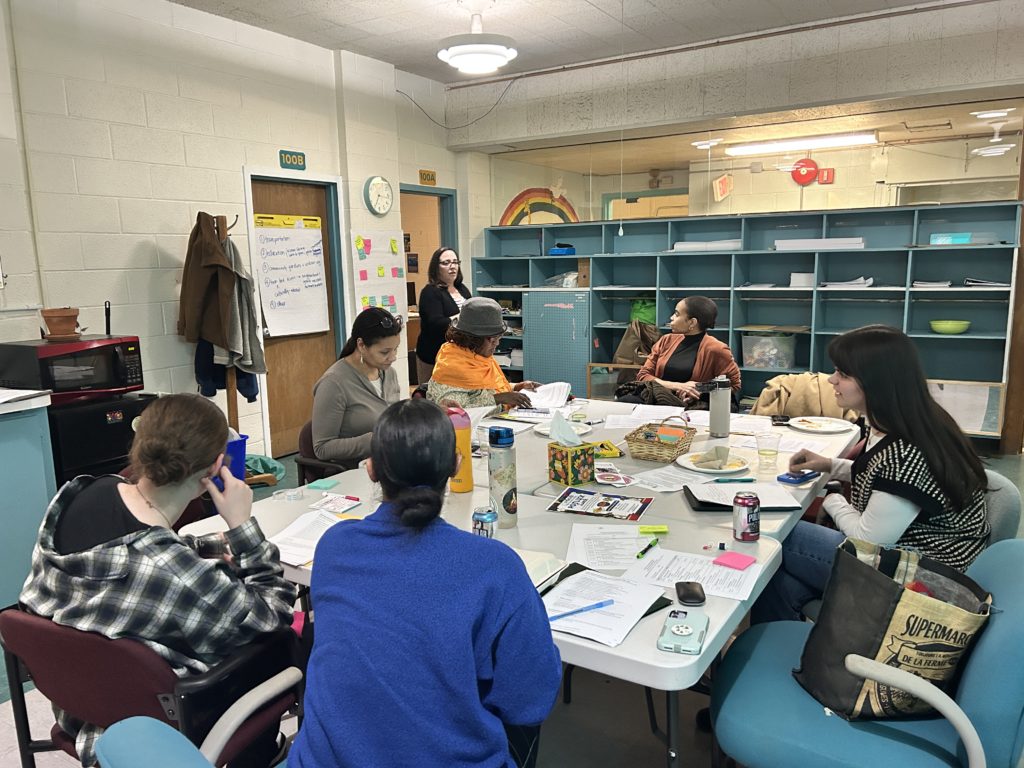
How are conflicts of interest dealt with as part of the FJF Leaders’ process?
A conflict of interest happens when someone involved in reviewing applications has a personal or financial connection to a person or organization applying for funding. This could mean they work for the organization, are a close friend or family member of someone applying, or could personally benefit from the funding decision.
Members of the FJF Leadership Council are not eligible to apply for funding for grant funding for a project they are directly involved with, however, other conflicts of interest may still emerge.
If an FJF Leader has a conflict of interest with an application, they will disclose that in writing as part of their application review. They will also step back and not take part in reviewing, scoring, or discussing that application. This helps make sure the process is fair for everyone.
How will community voting work?
Community voting will take place through an online balloting system developed by the Crowdsourced Democracy Team at Stanford University. Any resident of Syracuse, Onondaga County, and Onondaga Nation over the age of 14 is eligible to vote one time throughout the voting period.
Voting will be available in the following locations:
- In-person at any Onondaga County Public Library location during their open hours.
- Visit https://www.onlib.org/locations to find a location near you. Ask at the circulation desk to receive a unique access code.
- Remotely from your phone or personal computer using SMS verification.
- In-person at the Gather & Grant Celebration (Beauchamp Branch Library) – Thursday, April 24h from 5:30-6:30pm. On-site interpretation services and childcare will be available.
We will use “knapsack” style voting where participants will have the opportunity to fill their “bag” with projects to decide how this year’s Food Justice Fund grants are awarded. Results will be automatically tabulated at 6:30pm on April 18th and the awardees will be announced later that evening!
You can preview the ballot anytime at this link: https://pbstanford.org/2024-sofsa
How can I contribute to the Food Justice Fund?
This year’s annual campaign “Plant a Seed with SOFSA” will again be dedicated to fundraising for another round of Food Justice Fund grants in 2025. To make a contribution, please visit:
https://www.zeffy.com/donation-form/plant-a-seed-with-sofsa
GRANT APPLICATION INSTRUCTIONS
Where can I find the grant application?
The application is available at https://wkf.ms/4jj0NJe. Applications open on February 15th and are due March 14th Sunday, March 16th <Deadline extended> at 5pm. Late applications will not be accepted.
Only online applications will be accepted.
What are the funding priorities for 2025?
Each year, funding priorities for the Food Justice Fund grants are determined by the Food Justice Fund Leadership Council (FJFLC). Their decision-making is informed by their personal perspectives on the food system as well as data collected by SOFSA through our Community Listening Sessions, Food Justice Gathering exit surveys, working group conversations and more.
For 2025, the FJF Leaders are excited about the following priorities, but are also curious to hear any great ideas that you may have for high-impact food justice projects:
- Access to fresh/culturally relevant food
- Capacity-building for grassroots organizations
- Youth & seniors
- Pop-up markets
- Community gardens/urban agriculture
- Something else exciting!
What does “grassroots capacity-building” mean as a funding priority?
One of this year’s funding priorities is grassroots capacity-building for food justice groups, organizations, and businesses. While these projects may not always have the most eye-catching photos or immediate visible impact, they are essential for strengthening the foundations that allow community-driven work to thrive.
This could include budget or fundraising training, strategic planning, leadership retreats, technology upgrades, staff or volunteer development, and other efforts that build long-term sustainability. By investing in these behind-the-scenes efforts, we’re helping organizations grow their impact and create lasting change.
Projects that are primarily in this priority category are likely to be considered for Track 2 funding.
What are the two different “Tracks”?
Unlike in 2024, the tracks for this year’s Food Justice Fund grantmaking will be determined by the FJF Leaders when they review applications as opposed to by the applicants themselves. Both tracks are still designed to support and empower our community’s grassroots leaders in advancing food justice, but offer some flexibility for FJF Leaders to make nimble decisions based on the information included within the application
Track 1: Public Voting
From among all the applications received, FJF Leaders will determine up to 15 projects to advance to the public voting stage where community members will have the opportunity to weigh in about which projects:
- Have the highest potential for impact
- Are most innovative and/or creative
- Represent the greatest value for the investment of funds
Track 2: Trust-Based Process
New for 2025, the FJF Leaders reserve the right to directly fund up to 5 projects that they believe represent a pressing need in our community. Responses to Question 19 on the application will significantly influence their decision-making for Track 2 projects. We ask for the broader community’s trust in the FJF Leader’s determination of projects best suited for Track 2 funding.
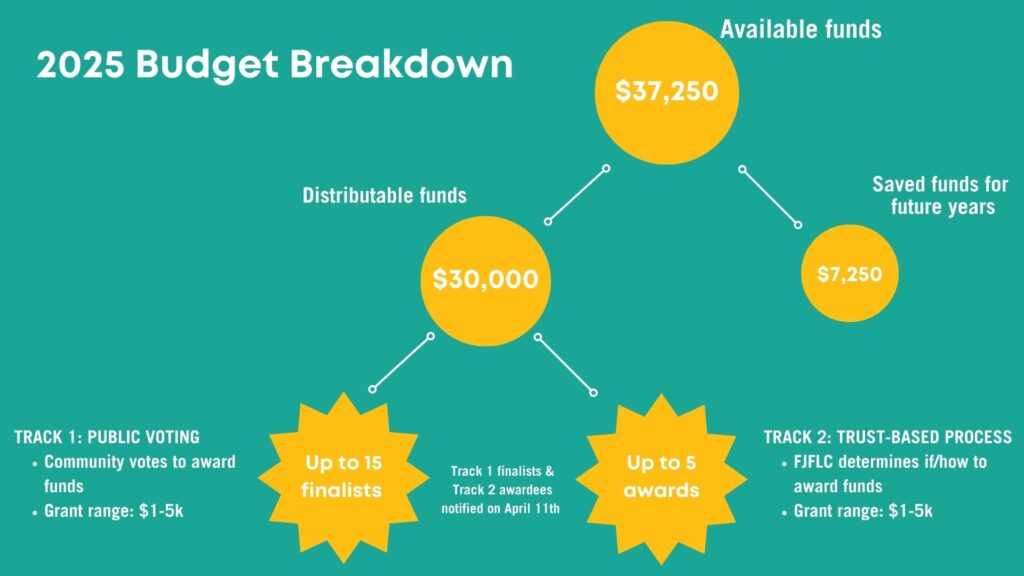
What information is the funding freeze/Executive Order question aiming to gather?
Alongside many others in our community and nationally, we know that local food and farming organizations are experiencing negative impacts from federal funding freezes and Executive Orders. The FJF Leadership Council would like to understand if you are facing or anticipating any challenges so that they can consider that in prioritizing applications – particularly for Track 2 funding.
What parts of the application are public-facing and which will only be seen by the FJF Leadership Council?
In this year’s public voting process, we’re making a change to keep the focus on project ideas rather than organizational recognition. The public ballot will include key details like the project title, location, priority areas, a short overview, requested funding, how the funds will be used, and a project photo—but not the name of the applying organization. More detailed information, will only be reviewed by the Food Justice Fund Leadership Council and advisors. The chart below breaks down what’s public and what stays confidential.
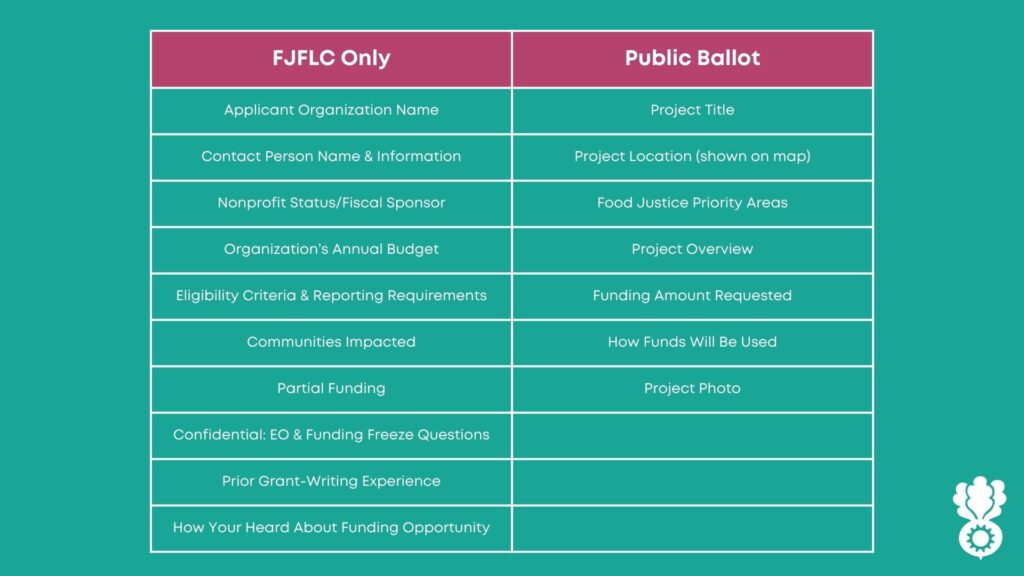
Where can I find the Info Session recording?
Recording Summary & Timestamps
- Overview of Food Justice Fund Community Grantmaking [0:00 to 4:40]
- 2025 Funding Opportunity Details
- Eligibility [4:51 to 5:54]
- Funding Priorities for 2025 [5:54 to 7:00]
- Available Funding and Funding “Tracks” [7:00 to 9:24]
- Grant Application Instructions [9:24 to 26:38]
- Key Dates [26:39 to 27:47]
- Q&A [27:47 to 46:33]
Where can I get application support?
Application assistance is available by appointment. Please contact Renee Marcoux at renee@syrfoodalliance.org or 315-552-0488.
Please note: Application assistance will be limited in the week leading up to the grant deadline. Please plan ahead and request assistance as early as possible.
FREQUENTLY ASKED QUESTIONS
How many applications may I submit?
While we recognize that there are many great ideas, we ask that each applicant submits only one proposal. There is no limitation on collaborations. For example, an applicant may be a collaborator on multiple projects but cannot be the primary recipient of funds for more than one application.
Can I apply for funding if I am not part of a nonprofit organization?
Unfortunately, this year Food Justice Fund grants can only be made to nonprofit organizations. However, applicants may still apply under the umbrella of a “fiscal sponsor”
“Fiscal sponsorship” is when a nonprofit organization agrees to support a smaller group or project that doesn’t have its own nonprofit status. The sponsoring nonprofit handles the financial and legal responsibilities, like managing grant money and donations, so the sponsored group can focus on its work.
Can past grantees receive funding in 2025?
In order to ensure an equitable distribution of Food Justice Fund resources, the decision has been made that 2024 grantees will not be eligible for repeat funding in 2025. This year’s FJFLC will be responsible for making a determination about eligibility for 2026 and beyond. Prior SOFSA Community Listening Partner grantees are eligible to apply for the Food Justice Fund.
How will funding “remainders” be dealt with?
As you may be aware if you’ve previewed the ballot from 2024, you’ll notice that there is frequently no configuration of the finalists’ projects that will have us arrive exactly at the available funds for this year’s Track 1 grants.
- Once voting closes, the projects will be ranked based on the votes received.
- We’ll begin by allocating funds to the project receiving the highest amount of votes and will continue in order for each project.
- At some point as we go down the list, we’ll have some funds remaining but not enough to fully fund the next top-ranked project.
- If that remaining amount exceeds $1,000, the remaining funding will be awarded to the next top-ranking project that is willing to accept partial funding.
- If the remaining amount is under $1,000 (or $2,000 in the event of a tie for that spot), that funding will be carried forward to the future Food Justice Fund grantmaking.
Why should we avoid naming the organization/applicant in the Project Title and Project Overview questions? What are some tips to do this?
The Food Justice Fund Leaders want the public to vote on project proposals based on their merit, without considering prior experience with an individual or organization. While some voters may still recognize your organization from other details, this process strives to add a level of anonymity.
Rather than naming the organization itself, please consider this guidance to support you to answer these questions.
- Project Title (Question 1): A descriptive project title will help the public know right away what it is that you’re aiming to achieve through your project. Think about if someone doesn’t read any further – will they know roughly what you will be doing? Choose a title that uses descriptive words to talk about your project’s activities and/or impact. Some examples from 2024 include:
- Culturally Significant Produce Donations
- Feeding Families: A Farm Education Partnership
- Eat Well, Age Well
- Project Overview (Question 13): Use words like “we”, “our”, and “the project” in place of your organization’s name or other identifying information.
- Example: The proposed project aims to address food insecurity and inequality among disabled individuals in Syracuse and the greater CNY region, with immediate implementation upon receiving the grant. By tackling barriers such as limited mobility and financial constraints, the project seeks to provide access to nutritious food and advocate for equity. Through these efforts, the initiative aims to create a more inclusive and supportive environment, promoting long-term resilience and empowerment within the disabled community.
What are you looking for in the Project Overview section?
In the application, there is a 5-8 sentence Project Overview section. This intended to be a public-facing “sales pitch” that the community will read during the voting process. If your proposal is advanced to the community voting phase, a shortened version of the response in this field will appear on the ballot as the description of your project. You are encouraged to explore the Sample Ballot to see how projects will appear to voters.
What is an indirect cost?
Indirect costs are costs that cannot be directly attributed to a specific project. They are sometimes referred to as “overhead” or “costs of doing business”. This can include things like renting office space that’s used for more than just this one project or paying for a portion of a business’s insurance that covers all of its operations.
For the purposes of the Food Justice Fund, it is allowable to request a percentage of the budget for these costs, however indirect rates over 5-10% are discouraged. The voting public may or may not understand the concept of indirect costs so applicants are encouraged to make sure their response to the Use of Funds question helps folks understand why their project is a good value.

What are the reporting requirements?
Grantees are expected to provide the following in terms of reporting on their project’s outcomes:
- A story about the success of the project to be shared at the Food Justice Gathering in October 2024
- 3-5 photos or videos of your project to be shared with the SOFSA network
- Completion of a brief awardee survey to help improve the process for next year
If my project is awarded, how long do I have to spend the funds?
We expect funds to be spent within 12 months of being disbursed. Thus, the project activities for FJF 2025 should take place between May 1, 2025 and April 30, 2026.
What if my actual expenditures vary from those I proposed in my budget?
We know that actual expenditures may vary from those in the initially proposed budget. Within reason (and not to exceed 50% of the total award amount), grantees may shift costs to meet the realities of executing the project.
- All expenditures must be directly related to the community-approved project’s overarching goals or intent.
- Grantees must submit budget modification requests in writing to director@syrfoodalliance.org prior expending grant funds outside of the approved budget.
SOMETHING ELSE?
What if my question isn’t answered yet?
- Please plan to attend the Info Session on February 26th or submit your question in advance via the online form prior to that date.
- After that time, you will need to request individual application assistance to have your question(s) answered.

